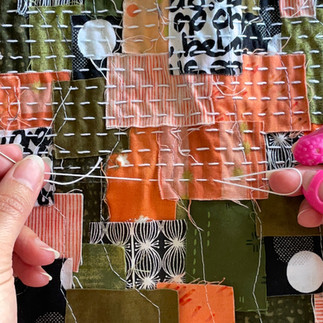In my Patchwork Sashiko Method there's a lot of little movements, that although seem inconsequential, add up over time. So, how these little movements are performed over and over can affect your slow-stitching experience. What is she talking about?? Well, hopefully you read my previous post about "pulling the needle through the fabric". It's another example of minor changes to movements and how you think about the movement that results in big impact over time. THIS post is about the movement right after the needle is free and you're left with little folds of fabric. Now what? Umm, pull the thread out obviously... Yes, but how? Many of us who have done hand embroidery or hand sewing have a motor memory about what happens once you made the stitch. Pull up on the needle to pull the thread through, thereby completing the stitch. When I teach my method, I encourage students to think holistically about the entire process. And in keeping with that thought, this post will share how I pull the thread through the fabric and why I think you should try it! The video on my YouTube page is the best way to learn so you can see exactly what's happening and you can either click on the first image or there is a button that links to the video at the end of this post.
Let's start with my "Peach Harvest" color palette from my Patchwork Sashiko Kits. Each time I push my needle through the patchwork pieces, the last step is to pull the thread through the fabric and complete the stitches. I will typically load anywhere from 3-7 folds of fabric onto my needle. But imagine, looking at the image, how many times this happens over the course of one textile...LOTS. So, how you pull the thread through can either make your experience go smoothly, or cause you frustration. Let's see what I mean...
I'm going to start with how I DON'T want you to do it :) In Figure 2 you'll see that my needle is free of the fabric and I have some folds of fabric.
Notice in Figure 3 I'm pulling UP on the needle with my thimbled hand. I've also seen the needle pulled in the direction of the stitching, but still with the thimbled hand so that it creates an awkward motion where your right hand is stretching to the left or vice versa if you're left handed.
The puckering that was created when we pushed the needle through remains or becomes MORE puckered as we're pulling. Also, the thread twists as you're stitching and over time will create lots of curls and potential knots if you don't unfurl it. It didn't occur in this instance, but pulling on the needle and allowing the loop of thread to hang loose will encourage more knotting of the thread.
So, what do I suggest then? Glad you asked! Let's start over where the needle is free from the fabric in Figure 4. Instead of using my thimbled hand to pull the needle I'm going to switch hands as seen in Figure 5. This alleviates my right hand from trying to pull the thread to the left across my body. Then, my thimbled hand is free to add stability to the free thread loop in case it tries to curl up on me.
In Figure 7, you'll see I continue to pull the thread to the left and notice, unlike in Figure 3, my folds have not remained puckered, but have started to smooth out. Also, a finger on my right hand remains inside the thread loop keeping it knot-free. Then, voila! Thread is pulled through the fabric will minimal puckering and awkwardness!
Remember, done once or twice it may not seem like a big deal. But because this motion is repeated many times throughout the stitching of the textile, having a consistent method with minimal movement will make the experience far more enjoyable. I hope this has been helpful to you! Click the button below to be taken to the YouTube video...
Curious about the textile you saw above and want to try it for yourself? Visit my Etsy Shop for Patchwork Sashiko Kits and the Instruction Manual
Have a project you made with my patterns? Share it to Instagram or Facebook and tag me! @banjoflannel
Scroll down to subscribe to my newsletter for my latest posts, projects and exclusive discounts! 👇














Makes perfect sense! Thank you for sharing.